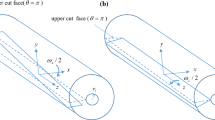Abstract
This paper analyzes crack nucleation from a wedge disclination dipole in the presence of a remote stress, accounting for the shift of the rotation axes within the dipole arm of the disclinations. A Zener–Griffith crack is assumed and an energy method is employed for the analysis. A single energy equation determines the equilibrium crack lengths and the crack head opening. Uniaxial and biaxial dipoles are compared: in the former the disclinations share a common rotation axis while in the latter the axes are separate. The results show that stable and unstable cracks can nucleate from the positive disclination of the dipole, but some of them are energetically unfavorable. A uniaxial dipole is stable against crack nucleation when the axis is located away from the positive disclination. Biaxial dipoles are more stable when the rotation axis of each disclination approaches the defect line of the other disclination. If the negative disclinations of a uniaxial dipole and a biaxial dipole have the same axis shift, the critical nucleation stress of the biaxial dipole is larger if its positive disclination shift is more than that of the uniaxial dipole. Stable crack lengths generally increase, while the crack head openings decrease, with the axis shift of the positive disclination. The crack head opening to crack length ratio is of the order of 0.001–0.01, and can be higher if an applied stress is present.










Similar content being viewed by others
References
Cordier P, Demouchy S, Beausir B, Taupin V, Barou F, Fressengeas C (2014) Disclinations provide the missing mechanism for deforming olivine-rich rocks in the mantle. Nature 507:51–56
de Wit R (1973) Theory of disclinations: IV. Straight disclinations. J Res Nat Bur Stand A Phys Chem 77A:607–658
Gutkin MYu, Ovid’ko IA (1994) Disclinations, amorphization and microcrack generation at grain boundary junctions in polycrysalline solids. Philos Mag A 70:561–575
Krasavin SE (2007) Residual resistivity due to wedge disclination dipoles in metals with rotational plasticity. Phys Lett A 361:442–444
Li JCM (1972) Disclination model of high angle grain boundaries. Surf Sci 31:12–26
Liu YW, Fang QH, Jiang CP (2006) A wedge disclination dipole interacting with a circular inclusion. Phys Status Solidi (a) 203:443–458
Lyles RL, Wilsdorf HGF (1975) Microcrack nucleation and fracture in silver crystals. Acta Metall 23:269–277
Murayama M, Howe JM, Hidaka H, Takaki S (2002) Atomic-level observation of disclination dipoles in mechanically-milled, nanocrystalline Fe. Science 295:2433–5
Nazarov AA, Shenderova OA, Brenner DW (2000) On the disclination-structural unit model of grain boundaries. Mater Sci Eng A 281:148–155
Pertsev NA, Romanov AE, Vladimirov VI (1981) Disclination-dislocation model for the kink bands in polymers and fibre composites. J Mater Sci 16:2084–2090
Romanov AE (1993) Screened disclinations in solids. Mater Sci Eng A 164:58–68
Romanov AE, Vladimirov VI (1992) Disclinations in crystalline solids. In: Nabarro FRN (ed) Dislocations in solids, vol 9. Elsevier, New York, pp 191–402
Rybin VV, Zhukovskii IM (1978) Disclination mechanism of microcrack formation. Sov Phys Solid State 20:1056–1059
Seefeldt M (2001) Disclinations in large-strain plastic deformation and work-hardening. Rev Adv Mater Sci 2:44–79
Suhanov II, Ditenberg IA, Tyumentsev AN (2015) Theoretical analysis of features of dipole and quadrupole configurations of partial disclinations in nanocrystals of metals. IOP Conf Ser Mater Sci Eng 116:012035
Wang T, Luo J, Xiao Z, Chen J (2009) On the nucleation of a Zener crack from a wedge disclination dipole in the presence of a circular inhomogeneity. Eur J Mech A Solids 28:688–696
Weertman J (1996) Dislocation based fracture mechanics. World Scientific Publishing Company, Singapore, p 524
Wu MS (2001) Characteristics of a disclinated Zener crack with cohesive end zones. Int J Eng Sci 39:1459–1485
Wu MS (2018) Energy analysis of Zener–Griffith crack nucleation from a disclination dipole. Int J Plast 100:142–155
Wu MS, Zhou H (1996) Analysis of a crack in a disclinated cylinder. Int J Fract 82:381–399
Wu MS, Zhou K, Nazarov AA (2007) Crack nucleation at disclinated triple junctions. Phys Rev B 76:134105
Zhou K, Nazarov AA, Wu MS (2007) Competing relaxation mechanisms in a disclinated nanowire: temperature and size effects. Phys Rev Lett 98:035501
Author information
Authors and Affiliations
Corresponding author
Additional information
Publisher's Note
Springer Nature remains neutral with regard to jurisdictional claims in published maps and institutional affiliations.
Rights and permissions
About this article
Cite this article
Wu, M.S. Crack nucleation from a wedge disclination dipole with shift of rotation axes. Int J Fract 212, 53–66 (2018). https://doi.org/10.1007/s10704-018-0292-9
Received:
Accepted:
Published:
Issue Date:
DOI: https://doi.org/10.1007/s10704-018-0292-9




